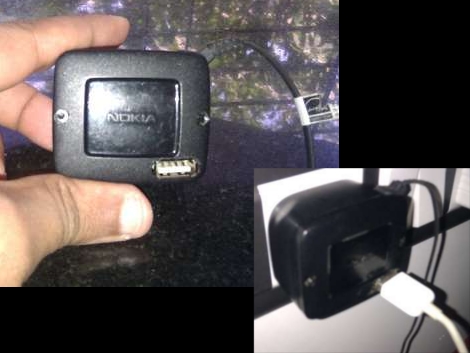
We still can’t figure out why a standard charging scheme hasn’t been developed for handheld devices (other than greed). Certainly we understand that many devices have different electrical needs as far as voltage and current are concerned, but we still long for the ability to use one charger for many different doodads. [Rupin] is trying to narrow down the number of dedicated chargers he uses by adding a USB charging port to his Nokia cellphone charger. Since the USB standard calls for regulated 5V a hack like this can often be done just by patching into the power output coming off of the voltage regulator in the plug housing of the device. [Rupin’s] charger had 5V printed on the case, but when he probed the output he found well over 8 volts. He added a 7805 linear regulator to get the stable output he needed, then cut a hole in the case to house the connector.
Since [Rupin] wants to use this as an iPod charger he couldn’t just let the two data lines float. Apple uses a specific charger verification scheme which requires some voltage dividers to get the device to start charging.















I think I would just buy a USB 5V wall adapter for 1 dollar off amazon…
@Brian, good for you. the article said he wanted to charge his Nokia and ipod from the same adapter.
We would appreciate if you would keep your negative comments to yourself.
http://europa.eu/rapid/pressReleasesAction.do?reference=IP/11/136 <- Manufacturers deliver the common mobile phone charger
if it’s a dollar, probably isn’t regulated, just like Rupin’s.
The output is regulated, but not unloaded. If you add a few mA of load to that charger it will stay at 5V. It’s a common problem with smps chargers when unloaded.
yep, just what I was thinking reading the post. I’ve added a resistor dummy load of 200 Ohm to save that spike of paranoia when pluggin in a $700 mobile to a nokia charger piece of ****
Did this already to the charger for my nokia bluetooth headset, I can charge it in the car with a usb charger or at home with a usb cable in the charger.
Use the 7805 it is a waste of energy. The source is regualted but need some ammout of load!
@Brian – “…just buy a USB 5V wall adapter for 1 dollar off amazon…”
He’s combining two functions into a single charger. That’s not the same as buying a second charger for the second function. From the summary “[Rupin] is trying to narrow down the number of dedicated chargers he uses”
@bogdan
Even if it is regulated (with a load) are you sure that particular charger is 5V? For example, 7.5 volts regulated isn’t going to do him any good.
Sorry, just RTFA… yup, it’s 5V.
You just cannot trust anything you see on Instructubles and this is a good example. Would it work? Yes. Is it efficient? No. 7805 has 2V dropout voltage, so he is actually generating less voltage to charge his iPhone (and a lot of unnecessary heat).
considering the input voltage is 5V, that is…
@veneficus you are right. The minute he adds load to it, the voltage will drop.
It would be more expensive to make the charger regulate when it is unloaded and pointless. It has to charge the phone, and the phone probably provides minimum load anyway.
In fact, if you look at some datasheets for these kinds of adapters, you will see that the voltage is said to be x +/- 5% (or whatever) for load 10% to 120% of rated or something like this.
I did something similar a while and found only one of my various Nokia chargers actually put out the promised 5V (model AC-4X). I cut the cable, adding a pair of USB sockets in place of the original plug, then added a USB socket onto the cut end of the remaining cable so I could plug it back in and keep the original charging function. The thing puts out 890mA which is just enough to charge 2 USB devices.
First of all: Old linear regulator = Bad idea. I would be interested to see the output voltage of his charger under load – My guess is that under load, the thing will drop out due to the minimum voltage differential between the input and output pins of that IC. Much better to use a small switch mode converter.
Better idea: Make a USB-to-nokia adapter, and get a small generic USB adapter.
Voltage is always higher than indicated on those cheap wall warts. You need to load them. Some are nothing more than a transfo with a diode.
A problem I see is if the load ‘that was meant for it’ takes it from 8V to 5V, loading it further might continue this linear relation.
I also suggest you scope Vout because it might not be as flat as you think. Newer iphones for example are sensible to a shaky usb charging voltage (ie: square wave inverters).
The wall adapter of cellphones in China is already standardized to 5V USB. They can simply use the same adapter for different devices as long as the current is enough.
BTW the factories there can make a $0.5 regulated USB adapter using 13001. Current will be 300mA max.
Thanks for your comments.
One update- I tried charging both the Nokia phone and my iPod, and the iPod stopped charging.This might throw light on the concerns people have on the design.It could probably be because of the drop in the voltage at the input of the 7805.
i also make usb charger form nokia only at 0.4$ cost, explained at http://screwdesk.com/charge-usb-devices-with-nokia-charger/
above link transferred to http://khalsalabs.com/charge-usb-devices-with-nokia-charger/